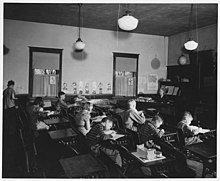Our website is made possible by displaying online advertisements to our visitors.
Please consider supporting us by disabling your ad blocker.
One-room school

One-room schools, or schoolhouses, were commonplace throughout rural portions of various countries, including Prussia, Norway, Sweden, the United States, Canada, Australia, New Zealand, the United Kingdom, Ireland, Portugal, and Spain. In most rural and small town schools, all of the students met in a single room. There, a single teacher taught academic basics to several grade levels of elementary-age children. While in many areas one-room schools are no longer used, some remain in developing nations and rural or remote areas where scarce students or teachers complicate organizing the educational process differently.
In the United States, the concept of a "little red schoolhouse" is a stirring one, and historic one-room schoolhouses have widely been preserved and are celebrated as symbols of frontier values and of local and national development.[1] When necessary, the schools were enlarged or replaced with two-room schools. More than 200 are listed on the U.S. National Register of Historic Places.[2] In Norway, by contrast, one-room schools were viewed more as impositions upon conservative farming areas, and, while a number survive in open-air museums, not a single one is listed on the Norwegian equivalent to the NRHP.[1]
- ^ a b Leidulf Mydland (Spring 2001). "The legacy of one-room schoolhouses: A comparative study of the American Midwest and Norway". European Journal of American Studies. 6. doi:10.4000/ejas.9205.
- ^ See Category:One-room schoolhouses in the United States.
Previous Page Next Page


